I’m going to start this by admitting that this is the VERY first time that I’ve ever made my own chicken broth. I’ve been meaning to for years… and it’s almost hypocritical of me not to, but for some reason I never got around to trying it.
So, don’t read this post as a “definitive guide” to making chicken broth, but rather a “here is my experience, you should try it too!” Also, because I know there are A LOT of you who have been doing this for years, I’d love it if you’d share your tips, tricks, and experiences in the comments so that we can all learn from each other :)
So what was my experience? OMG, so easy. Seriously, dump it all in the pot and let it go. Come back later and you have a magical golden liquid full of flavor and good for you nutrients. Why wouldn’t you want to do this?! Plus, I always get warm and fuzzy inside when I know that I’ve reduced my waste. By making broth you get to use every last bit of goodness in your chicken and vegetable scraps. I can’t wait to make some vegetable broth too!
A couple good tips I’ve already gotten from readers:
1) Save your vegetable scraps from other recipes in the freezer until you’re ready to make broth. Just make sure they’re well washed first to remove sand and dirt.
2) Theresa suggested making the broth in a slow cooker instead of on the stove top for even less baby sitting. Let it go all night and you’ll have an ultra-amazing broth by morning!
I can’t wait to hear everyone else’s tips!
Homemade Chicken Broth

This post contains some affiliate links, which means that we make a small commission off items you purchase at no additional cost to you.
How to: make chicken broth
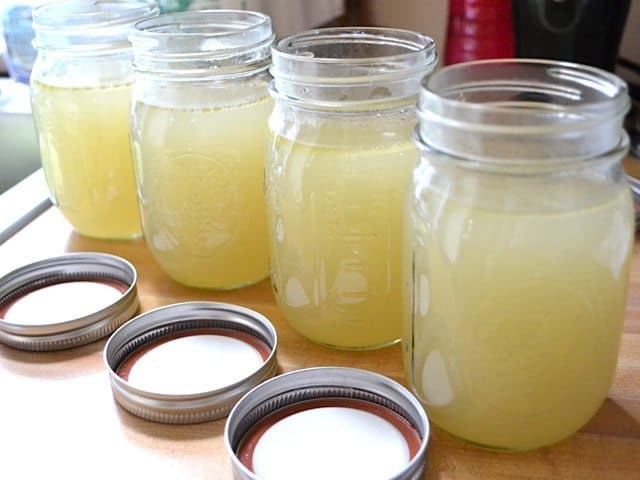
Ingredients
- vegetable scraps
- chicken carcass
Instructions
- Pick the skin from the chicken carcass and make sure you’ve gotten all of the good meat off. Leave the cartilage as this will “melt” into the broth, adding flavor and nutrients. Yes, cartilage has nutrients. It’s like taking a joint supplement pill, but it tastes better.
- Make sure your vegetable scraps are clean by rinsing well with cool water. You can use the ends and stems of carrots, celery, herbs, onion skins, or any piece of a vegetable that you normally cut off and throw away. The vegetables WILL effect the flavor, so make sure you use vegetables that “go” together. I used celery, carrots, parsley stems, and onion skins.
- Add the chicken carcass and vegetable scraps to a large pot and cover with water (about 12 cups, depending on how big your chicken was and how many scraps you have). Bring up to a boil over med-high heat, then reduce to low and let simmer with a lid for 3-4 hours.
- After simmering, pour the broth through a colander into a large bowl or pot. Remove the colander and throw away all of the scraps. Cover the colander with a cheese cloth or another clean, lint-free cloth and pour the broth through once more to remove small particles.
- Divide the broth into smaller containers to help facilitate cooling. Refrigerate until cold and then transfer to the freezer, remembering to label and date each container.
See how we calculate recipe costs here.
Notes
How to Make Chicken Broth – Step By Step Photos
So, I roasted a whole chicken in my slow cooker last weekend, and after it was cool enough to handle I picked the meat off and saved the bones and scraps until I was ready to make the broth.
The next day, after I had accumulated some vegetable scraps, I started the broth. First things first, make sure the vegetable scraps are CLEAN. Sand in broth is not good. I had celery tops and stems, carrot ends and peels, onion peels, and some parsley stems. Place them in a large pot along with your chicken carcass.
Cover the whole thing with fresh water. I used 12 cups. Bring the pot up to a boil over medium-high heat and then reduce it to low and let simmer (with a lid) for 3-4 hours.
After you’ve simmered all of the goodness out of your scraps, it’s time to strain out the magical golden liquid. Place a colander over a large bowl and pour the whole pot through it. Discard the collected scraps.
After the first strain, this is what I had. It’s already golden and beautiful. And it smells delightful too.
You’ll want to strain a second time through a fine weave, lint-free cloth to remove any small particles that may have passed through the colander. I just laid my cloth out over the colander and poured through again.
It didn’t catch much, but I bet if I had simmered for longer everything would have broken down more and there would be more small particles.
You can season your broth at this point with salt and pepper, but I prefer to leave it unsalted and then just add salt later when cooking with the broth. Adding salt at the end of a recipe allows you to use less and achieve the same flavor punch. Also, it’s always a good idea to divide your broth (or any food) into smaller containers before refrigerating so they cool down faster. Always chill the broth before placing it in the freezer.
I put my broth in jars because they were sitting there on my counter, but I like to freeze sauces and liquids in quart sized freezer bags. You can freeze in glass jars, but make sure to leave room for the liquid to expand as it freezes, or else your container will burst.


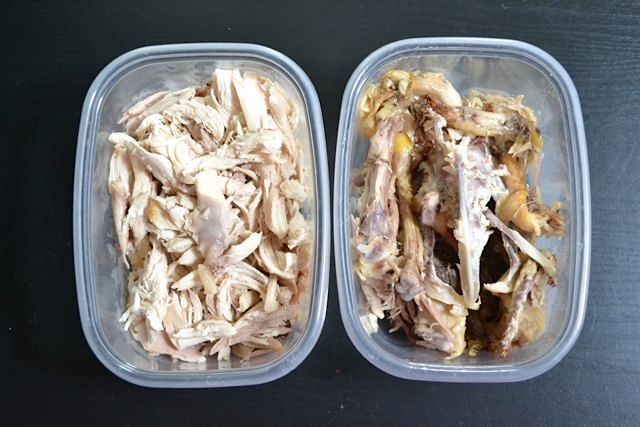


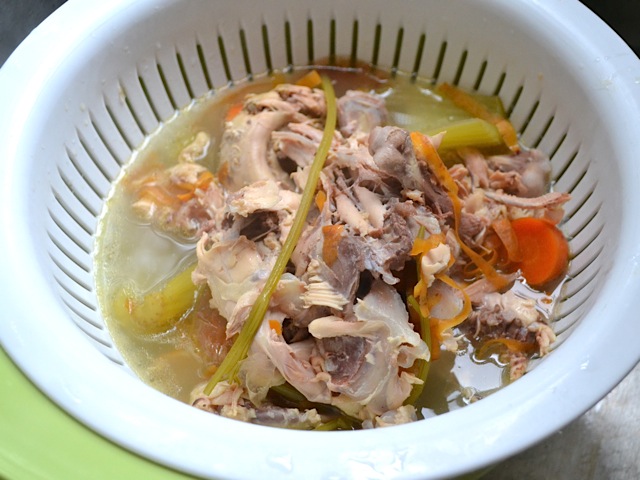
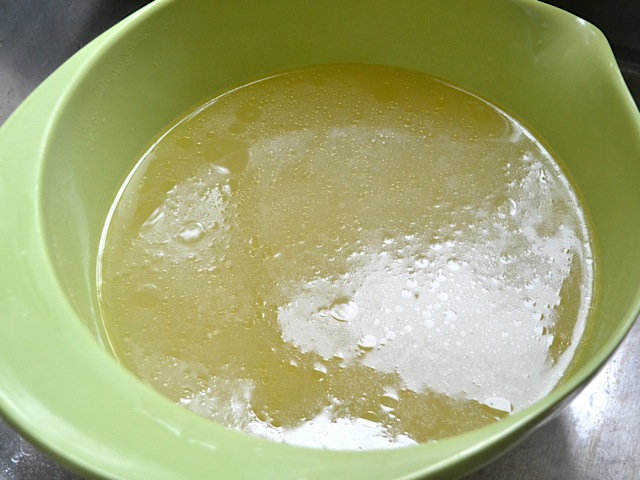
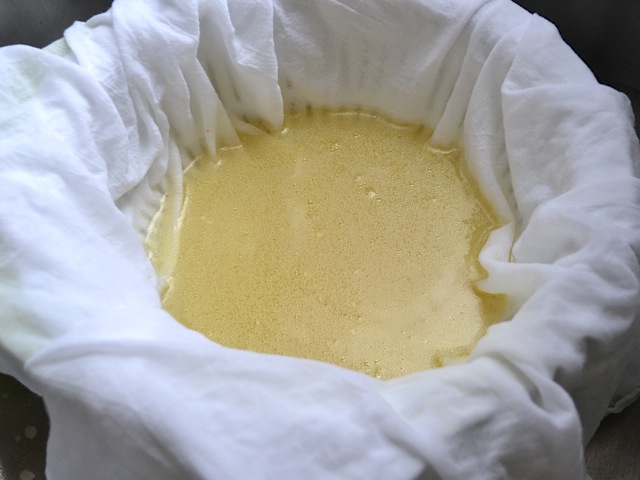

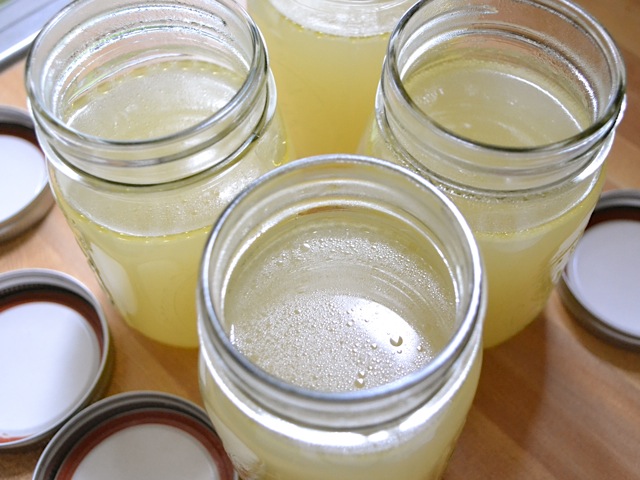
Maybe a stupid question but is broth the same thing as stock can they be used interchangeably for recipes?
Yes, they can!
My favorite thing to do during Thanksgiving or other big cook days where I’m going to make a stock after is to set up my stockpot nearby my work area. And then anything that I would be putting in the stock I just toss into the pot. When I’m all done in the kitchen I’ll load up any other stock bits and bobs into my pot and let it start while we eat.
Add the spice dried Chervil to enhance your flavor in place of parsley. Its known as the chicken spice. I always use dark meat from chicken legs and thighs. Dark meat has more juices than the usually dry breasts. I also leave the skins on. When I pressure cook them, bones and all. After cooking, I use my blender to emulsify the skin and add it to my stock. FAT is what gives you that deep, rich flavor you’re looking for. Don’t be afraid of it
Just wondered whether i should use chicken skin when making broth. I mean when it’s not very seasoned as when baking bone in breasts for shredding chicken to keep in the freezer. I know fat makes for good flavor but will it be too fatty if I use the skin?
It will definitely have quite a bit of fat if you use the skin. Whether that is “too much” is probably a personal preference.
I also do mine in the crockpot. Not only no babysitting, but if the chicken scraps don’t boil, the resulting broth with be clearer. I add herb. Usually bouquet garni ( rosemary, sage and thyme). If I want to use the broth for asian style soups, I add star anise, ginger, garlic clove and if I have it a piece of lemon grass.
I do this style of stock from veggie scraps and bones regularly and thought I would add that you can also save garlic skins and the main “root” with your scraps in the freezer. Adding that garlic flavor to the stock really kicks it up a notch.
Bonus if you throw in a bay leaf!
I make broth quite frequently since my children have many food allergies. I have learned that a nice way to get a darker broth with a deeper flavor is to roast my bones and veggies first in the oven. This works really well with beef and vegetable broths as well.
I like to include yellow onion skins with the onion which gives the broth such a rich color. I also add celery but I don’t care for carrot….too sweet for me.
When making broth, I put it in glass jars and I add a spoonful of unflavored coconut oil. While it cools in the fridge, the oil solidifies on top (make sure it is thick enough) and seals the broth. It keeps much longer this way. (However, if I wanted to keep it for a very long time, I would freeze it). When I need broth, I break the seal with a knife and use the oil to cook something else.
I have a very small freezer, so I tend to boil down my broth to about 1/4 of liquid thats left after I take out the chicken and veggies. This way I end up with less volume, but a highly concentrated broth- I just add more water when cooking with it.
Can you tell me what setting (low/high) and how long you would leave this in the slow cooker for?
Thekitchn.com suggests 10 hours on low, or 5 hours on high. :)
I make (and use) huge quantities of homemade broth. I only buy whole chickens and cut them up for use as breasts, thighs and (occasionally wings). I collect all the chicken backbones (often wings) and “extras” (livers, hearts that come in the bags) and freeze them in a 1/2 gallon freezer bag. I add to that bag until its full. Start another bag etc. When I need broth I use a couple of full freezer bags as my chicken source. I typically add a couple of whole onions, a head of garlic, 6 or 7 carrots, some dill and parsley. I need a very large pot!
I definitely second adding the pan drippings, it adds *so* much flavor. Well worth the extra fat, since it all solidifies in the fridge overnight and is easily skimmed off. Also, if you’ve saved the giblets, those can go in too (except the liver).
Love your blog, by the way, it’s nice to see someone sharing delicious recipes for people who are watching their budgets – and who isn’t, these days?
Adding in some whole peppercorns, fresh thyme, and fresh parsley really adds some awesome flavor!
I make broth a lot, and I pour it into a container (like a tupperware container?) and let it cool, then freeze it. Once it’s frozen (I freeze about 1 C in each container) then I can pop it out of the container after it’s been out of the freezer for about 5 minutes, and put them all in a gallon ziploc bag in my freezer. That way I can just grab 1, or 2 or however many cups of broth my recipe calls for and plop them right in. :)
Does anyone have a rule of thumb about how old the chicken you use to make stock/broth can be? The reason I ask is because I was wondering if it would be safe to use the left-over rotisserie chicken that’s been my refrigerator for about 1 week, 2 days; and some of the bones got left out on the counter for 3+ hours. Would it be safe to use any of this for making stock/broth? Thanks!
I wouldn’t use either of those items. General FDA food safety guidelines suggest not consuming any cooked food that has been at room temperature longer than 2 hours because that is enough time for bacteria to grow and produce toxins that can not be cooked out if reheated (or made into broth). The chicken in the refrigeratore, while not likely to have those toxins because it’s been refrigerated, is more likely to have other growth, like yeast, mold or other bacteria, that can produce off flavors. Neither of these things are guaranteed to happen, but it’s better safe than sorry.
A good way to save items like this for making broth is to freeze them. Just make sure to freeze them right away and not let them hang out in the fridge for a while or on the counter top. That way you can save them for a few months until you’re ready to make the broth.
Make sure to add some lemon juice or vinegar to help extract the calcium from the bones. I keep a stash of scraps in my freezer for stock – chicken necks, onion tops, tomato trimmings, corn cobs, green bean liquid… When I have a carcass it all goes in the stock pot.
i always make my chicken broth from a fresh (uncooked) chicken. I like it best with a whole chicken, cut up into about 10 pieces, plus maybe 6 carrots and 2 big onions quartered. First I boil the chicken pieces in a very little water, barely enough to cover, for maybe 2 minutes. Take it off the heat, run it under cold water and wash off all the blood (grey bit). Then return to pot with veggies and a lot of water, and simmer maybe… 45 mins? That’s all. Salt to taste, bay leaf if you like.
I find it better than cooked-chicken broth, and then you have all this lovely cooked chicken for salad, sandwiches, to eat with the soup, etc etc.
Fabulous! I’ve always heard not to leave the lid on while simmering, though, so evaporation can happen to concentrate the flavors.
Adding a splash (i.e. a tablespoon or two) of apple cider vinegar to the pot at the beginning helps coax out all of the wonderful minerals, such as calcium, from the bones of the chicken as the stock simmers(and does not leave a distinctively ‘vineager-y’ flavor).
If you pour the broth into ice trays then freeze them, you can have 1 oz. portions you can then throw in a freezer bag and keep in the freezer. Perfect for flavoring a small batch of something you are cooking up.
This is a great post and one I will try – as i’ve been meaning to do this. Most days I can only survive on chicken broth and it’s usually canned (gross), bullion (nasty), or organic box from Whole Foods (expensive). Thanks!! This is great!
Tianna @ http://www.alittlebitme.com
Sally Fallon’s recipe in Nourishing Traditions is awesome. If you are low on freezer space, you can reduce it and concentrate it so all you have to do is add water later.
I love home made stocks! Sometimes I add what’s in the bottom of the roasting pan after roasting the chicken. This ends up putting a lot more fat in the stock though, so you will end up having to scrape some off. Also I don’t bother with cheese cloth because that stuff usually settles to the bottom of the bowl and I can easily avoid it. I also save the celery leaves, chop them up, and add them to the soup right before serving.
I save veggie scraps in the freezer, and I usually save stems from fresh herbs to add to broth as well. These can add a lot of flavor. Parsley and thyme stems are perfect. Oregano and rosemary stems can be a little strong, so I use these sparingly.
I do this in my crockpot. Either roast or crockpot-cook the chicken, pick off (most of) the meat, then make the stock on low overnight.
At my grocery the hippie antibiotic-free chicken is about $9-$10, versus the deli counter, Boar’s Head rotisserie chicken deli meat is about $9.50 a pound.
DIY method? QUITE the deal.
I have learned making chicken broth from my Granny, and she alsways advised me, to cook the water first and cook the vegetables with it and when it’s cooking, add the chicken. The Meat will be more delicious than when you cook it from the beginning. I usually use the boiled chicken then with some of the broth to make pumpkin soup. Even my ever hesitating youngest loves this combination :)
I’ve been making my own broth for years now. Its wonderful, cheap, easy and provides our bodies with so many extra nutrients that would normally end up in the trash/compost. My husband did a year of cooking school and taught me this early on in our marraige.
One thing, he says you can simmer a chicken broth for 3-4 hours but vegetable stock should only simmer for 45 minutes. I have no idea why, but I figure he must know what he’s talking about…or at least I’d like to think so ;)
I freeze my stock in the larger twist top ziploc containers, leaving a little space on top for expansion. They work great, and there’s less waste than using the bags as they’re washable. I use a dry erase marker to label the top with the type of stock (or soup) and the date.
I throw in a chicken bouillon cube or two as I’m making the stock for a richer chicken flavor.
In culinary school our chef would use mushrooms instead of carrots, helps the color of the broth. Also fresh veggies were a must. Personally I love adding leeks.
I’m a big fan of making stock, since it’s pretty much getting food for free. One of my favorite tricks is to get extra turkeys during the holidays and break them down – legs/wings get cooked and meat taken off and frozen for use in casseroles, etc., breasts removed and ground for burgers or to stuff into bratwursts, and the remaining carcass shoved in the crockpot to make stock. I love turkey stock for making risotto.
I do this too! I also throw in some garlic and dried rosemary/oregano and a bay leaf. I’ve found it’s best not to use “stinky” veggies (there’s probably a better word for that but I can’t think of it) like cabbage, broccoli, cauliflower, peas, etc in the actual broth making. I’ll add them to the broth after if I turn it into soup, but I think they give the broth a weird muddy flavor.
I make mine in the crockpot overnight. You can do the same thing with your turkey carcass after Thanksgiving. Chicken broth from scratch is good, but it doesn’t compare in flavor to turkey broth! And if you leave the skins on the onions when you make the broth, they give it a nice deep, golden color.
Manuel Neuer
This is very nice love this main!
This comment has been removed by the author.
I just want to add that I LOVE making this in the slow cooker. After you’ve cooked up the chicken, you can throw everything together in the slow cooker and let it cook on low over night (8-10) hours. Wake up in the morning, and you’re good to go!
For the person who asked about using a turkey – it’s exactly the same. I do this with the carcass every year after Thanksgiving :) Since I know that’s what I’ll be doing, I save all my veggie scraps from Thanksgiving meal prep, which is usually bits of carrots, celery, and onions. I add it all to the pot with a few bay leaves and some whole peppercorns and let it cook throughout Black Friday!
I’ve made stock on the cooktop, in a slow cooker, and in a pressure cooker. It doesn’t make a lot of difference — mostly depends on what other time demands I have.
Lots of mirepoix and any or all of parsley, sage, rosemary, and thyme work great. You don’t need to grind black pepper – just add the corns.
I find the chicken fat distasteful in stock. I work hard to get it all out.
Once it’s clear I process it for an hour in a pressure canner and it keeps nearly a year on the shelf.
Has anyone tried pressure cooking the jars of stock after they are done? I’d like to keep some in the freezer and some just on a shelf in my pantry. I’m wondering how long to process them…
Knowing how to make a great chicken broth is so valuable . Thanks for the tutorial! I too keep a stash of vegetables for stock hiding in the freezer–I usually just make straight-up vegetable broth with it, though.
Does anyone preserve their chicken broth in a pressure canner? I’ve been thinking that this might be a good idea at some point. (I just have to get a pressure canner and learn to use it, but then!)
Re JESSICA & turkey:
I use our turkey bones/carcass every Thanskgiving. It’s great. It has a stronger flavor and slightly different – like turkey is different than chicken.
Personally, I tend to use turkey broth IN recipes alone (rather than cups of broth or clear soups, like I also do with chicken).
Perhaps ‘cuz my mom’s from Germany, but we always added juniper berries (which I always have on hand for various other dishes) and bay leaves. To be a GREAT budget buy, get whole chickens and spend a morning chopping them up yourself: breasts into one freezer bag, legs/thighs in another, wings/backs onto freezer bags.
For chicken broth, I just plop the frozen chicken (literally peeling off the plastic bag) into the pot, top with tons of veggies (MUST have celery, or, even better, celeriac root), begin the broth.
If you’re not familiar with the seasoning named Maggi (in German; I’ve seen this same bottle lined up on shelves in so many languages I couldn’t keep up!), you should run out and try it now. NO – don’t drink it straight from the bottle (although EVERY kid I know has tried, myself included), but add it to your chicken broth. NOTHING makes a sick person feel better than a simple, delicious cup of hot broth seasoned with some Maggi.
I used to make a pot of broth every week for my family (6 quart). First quart gone immediately in mugs with Maggi, then the rest used in various ways (have a list of fast soups ready to make, like a quick veggie soup, egg drop soup, avgolomono — OMG this is easy and good.
Enjoy! Welcome to the house-smells-so-good group!
I throw in 5 pepper corns when making my stock.
I cook my carcasses down to stock and then put it in ice cube trays and freeze it. I keep a couple of bags of poultry, beef and pork stock on hand. It’s concentrated, flavorful and “free”. (Beef and pork is typically the liquid left over from a slow-cooker roast unless I use it all up making gravy!)
When I worked for a caterer a hundred years ago she advised that adding an apple into stock-making provided just a little hint of sweetness to balance out the flavors. Just wash the outside and cut into largish pieces. It will all be strained out anyway so no need to peel or core. Maybe remove the stem if it’s long. Same person also used to like to add dill, fresh or dried. Me? I love to add ginger, fresh or dried…but that’s taking it in a more Asian direction. I find it gives complexity to anything else I do with it without being obtrusive.
Another tip I learned at The Restaurant School in Philadelphia a very long time ago: a bit of acid will help break down the bones to extract more flavor. For chicken, go with lemon juice. For beef, use any tomato product. Not quite as good as roasting the bones as someone else mentioned but a whole lot faster and easier IMHO. Just throw in at the beginning. You won’t taste it at the end.
Trained Chef Miss Maura in Charlotte, NC
I have started making my own broth this past year. I LOVE IT! I was afraid I would mess it up – but there is really no way. I do use my slow cooker. I purchase a whole chicken and cook it, and debone it, then put the remaining parts in the crock pot and cook all night, strain and freeze. Makes awesome chicken and dumplins.
I’ve made stock with just the carcass, with chicken pieces or whole chickens. All are great. I’ve made it on the stove top and in a slow cooker. I keep the seasoning pretty simple: carrots, onions, celery, parsley and/or bay leaf, salt and pepper. Maybe a little garlic. I don’t want another flavor to overtake the chicken flavor. I don’t want to taste too many herbal flavors or vegetables.
I make mine in a pressure cooker- you cook it for a fraction of the time, but the flavour is more intense. I also add an onion- skin and all which gives good flavour, but also a lovely colour.
I always make stock in my crockpot (I’ll use semi-frozen bones or fresh, doesn’t matter — semi-frozen cuz it takes a little work getting them to fit into the pot!). Generally, I can make two batches in a day! I freeze mine in old yogurt containers, but I’m really loving the ice cube idea. It would save me a lot more space and defrosting time. I also use rock salt and whole peppers, bay leaves, and other spices and herbs but I don’t bother putting it in a little sachet. I’m straining the whole mess once it’s done. What’s the point to keeping the herbs separate, you know?
Definitely be careful on what veggies you include. Once, I saved a bunch of broccoli stalks I had no use for and put them all in the chicken broth and it was inedible (ditto when I did it with strained fruit skins and cabbage cores I just didn’t want to throw away — I got into this weird “why can’t everything go into my stock?!” mode). Sometimes veggie garbage is just that — garbage. It’ll make your stock taste like it and you’ll end up wasting a good carcass.
Do make risotto with your new stock. It’s one of my favourite stock-made meals!
Can’t wait to try this. I’ll be fixing a turkey for a family get-together soon, what do you think of using a turkey instead of chicken? What, if anything, would I need to do differently?
This is wonderful. The idea to freeze the broth in ice cube trays works great. If you make your own veg or chicken broth, be sure not to put in veggies that can give you gas (think little tummies!) such as broccoli. I made veggie broth and put to many bell peppers -along with carrots, celery, etc. in to simmer for a couple hours. My family was bloated for days before I figured out what was causing it!
After the stock cools, I freeze it in ice cube trays in a tray where I know each cube is 1 ounce, and then put in a ziplock bag after frozen. Makes it very easy to use for recipes calling for smaller amounts.
Also, label the bags! I always think I’ll remember what I froze, but then I get beef stock confused w/ chicken stock, or (horrors) chicken stock ice cubes confused with frozen coffee ice cubes…
After the stock cools, I freeze it in ice cube trays in a tray where I know each cube is 1 ounce, and then put in a ziplock bag after frozen. Makes it very easy to use for recipes calling for smaller amounts.
Also, label the bags! I always think I’ll remember what I froze, but then I get beef stock confused w/ chicken stock, or (horrors) chicken stock ice cubes confused with frozen coffee ice cubes…
I just buy the cheapest raw chicken available at the grocery store and go with Bittman’s chicken stock recipe from “How to Cook Everything” (basic = carrots, celery, onions, bay leaf, fresh pepper (I leave the salt out too)- he includes and explains quite a few variations). That big red book has never steered me wrong :)
Sometimes, but only sometimes, I reduce it and freeze in ice cube trays. Most of the time I don’t because I go through it so fast anyway. I use it instead of water in just about everything except desserts…
I am planning on making stock in my crockpot because I have some bones and skin left over from a rotisserie chicken I bought a couple of months ago. The bones and skin are in a freezer bag in my freezer. Should I take these out first and thaw them in the fridge or can I just make stock from them straight from the freezer? Thanks – I’m a newbie at making stock!
I seriously just purchase a whole chicken for about $3, throw it in the crockpot full of water, set for 4 hrs. The meat falls off the bone, pull skin out and bones. Ta-da!! Youre dine.
The first time I made my own chicken broth I swore I would never go back to bouillon cubes. And I haven’t. :) It is just soooo much more flavorful and wholesome! I’ve tried both the crock-pot and stove-top methods and they each have their merits. To save a step I’ll sometimes pick up a rotisserie chicken from Costco (which I have found is comparable in price to a raw chicken at most of my local grocery stores). I’ll pick off the meat once it has cooled a little (I freeze it to use in pot pies or taquitos), then put the carcass in a stock pot with onion, celery, carrot, and a little sachet of parsley, sage, rosemary, thyme, and a bay leaf. I do add a tablespoon of salt at this point, but it usually still needs more salt when I use it in other recipes. I cover it with water (about 14 cups in my pot)and let it simmer for at least an hour and a half. If I am using an uncooked chicken I’ll put it in my 6 quart crock-pot, lightly seasoned with salt, then let it cook for about 5-6 hours on Low. After I remove the meat I’ll put the bones back in and add water till the crock is about 2/3 full and let it go on Low for several hours – overnight would probably be fine. The rotisserie stove-top version has more of a complex flavor from the veggies and herbs. The crock-pot version is more “chickeny” because I don’t usually add anything else. You can always mix and match flavors and methods to suit your preferences. I always keep some broth on hand in the freezer.
When I make scratch-made matzo ball soup I sometimes cook an extra chicken so that there’s more meat and then I just use the broth. Also, that fat at the top of the broth? It’s called schmaltz and is *excellent* for use in making matzo balls and dumplings. Just skim it off and dump straight into a batter.
Here’s my own method, which does involve a whole fresh or frozen chicken. http://nontraditionalunifood.blogspot.com/2012/08/home-made-chicken-stock-and-chicken.html
I freeze all the chicken bones/scraps/skins from whole chickens, legs, breasts, whatever I cook. I also freeze the cooking liquid from the bottom of the crockpot. A couple uncooked pieces of chicken are good for flavor, like wings, necks, or backbones. All of that goes into the stock pot with 2 onions, a couple stalks of celery, a couple carrots. The stockpot should be completely full of scraps and veggies before you fill it with water! Bring to a boil and simmer on low for at least 3 hours, skimming off any foam and fat. Then strain through cheesecloth, cool, divide, and freeze. I should point out that I have a 16 quart stockpot so I only have to make stock once or twice a year.
If you keep your broth to a low boil, it will be clearer- boiling makes broth/stock cloudy. Also, roasting your bones or carcass brings out a richer flavor. You can even smear some tomato paste on beef bones prior to roasting to add an extra sumpin-sumpin!
Making broth or stock is so wonderful- better flavor and you save so much money by using up what normally would have been thrown away! I add a sachet d’epices (cheesecloth tied up with thyme, parsley stems, bay leaf, and cracked peppercorn) when there is just an hour or two left of simmering to pack some extra flavor!